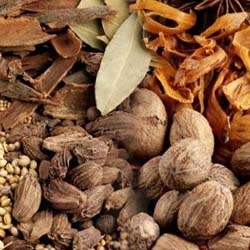How to Grind Spices

How to Grind Spices
When I talk to our customers I frequently find myself gauging where they are in their spice journey. By that I mean: There are four basic types of spice shoppers, dependent on their knowledge and experience with spices. I say four types but that is assuming that they have already made their way out of the wilderness (also known as the grocery store spice aisle) and are looking for better quality and fresher spices.
Table of Contents
The Four Stages of Spice Use
When budding foodies begin spice shopping for themselves, they can be somewhat intimidated with spices and go with spice blends. Blends are less risky and a new cook can get the best and most consistent flavor profiles using this method. The more experienced cook learns how food relates and they can read a dish, which allows them to cook with pinches and dashes--a pinch of this, a dash of that.
The second stage is when you decide to start making your own seasoning blends or adding a little of this to go with just a bit of that. For this stage you tend to go for spices that are already ground.
The third stage is when you've gained the knowledge of how spectacular spices are when they are ground fresh just before they are added to the recipe or dish. This is the "aha" moment; once you get here you never want to go back.
The fourth stage is when you begin to roast spices to release the volatile oils. Once you've started down this path you leave mere kitchen mortals in your aromatic dust. I'll talk more about this stage in another post.
For stages three and four you are going to need to grind your own spices. Here the choices are many and will depend on your own unique style, the amount of time you have and how much needs to be ground.
Time to Crush or Grind Your Spices
For smaller jobs, don't be afraid to try using a mortar and pestle. We have several in our kitchen and there's nothing quite like standing over them, and getting the wafting scents of spices cracking open and releasing their unique perfumes. But it's not great for bigger jobs, and can take a while for fine grinding. An easier and more efficient method of grinding requires a good quality electric coffee grinder. These don't have to be fancy (mine run about $20). I've researched online and tested probably 10 different kinds over the years and my favorite is the blade grinder from Krups.
Blade Grinders
Now there are certainly some tricks to using the blade grinders. They spin at a high speed and if you don't have a whole lot of spices in them the spices will fly to the top and won't get ground evenly. This certainly happens when you're only grinding a few teaspoons or less. Grind a slightly larger amount than you need and store the rest for a later use or add other dry ingredients from your recipe.
You do want to be careful of stripping out the blade on these grinders which can occur if a larger seed or berry gets stuck under the blade. One trick that I've learned is if I'm grinding cinnamon sticks, allspice berries or peppercorns is to turn the grinder upside down, turn it on and let the blades get up to speed and then turn the grinder upright to finish the job.
Pro tip: Never use the same grinder for coffee that you do for spices. There's nothing worse than coffee tasting like chile peppers or your cumin tasting like coffee. But I take this a step further and have several electric spice grinders in our kitchen. One is for earthy spices (i.e. cumin, coriander and mustards), one is for chiles, one is for the baking spices (i.e. cinnamon sticks and star anise) and one is for herbs. This makes clean up easier and you don't have to worry as much about picking up strong flavors in unwanted places.
Now while we love to grind spices fresh one spice we never grind in our blade style coffee grinders is whole cloves. These just wreak havoc on a grinder; the oil content really does a number on them. They tend to bog down the grinder a bit and really shorten the life of the grinder motors.
To clean my spice grinders I usually just wipe them out with a dry towel. If I need a better clean, toss a few tablespoons of dry rice or a piece of white bread into the grinder and let it run. They really do the trick.
Mortars and Pestles
As I mentioned we do have several mortar and pestles in our kitchen and they do have their place in any well equipped kitchen. I like using then when I want a coarser texture or when I just need a small amount. A pinch of this spice, a dash of that one and just a little of another and they can grind up quickly and easily.
You'll want to choose a mortar that has a rough bottom. The material it is made of can also make a big difference, depending on what you're grinding. Granite works best for hard spices, and choose ceramic for grinding small amounts. Use wood for bruising herbs. Wood is my least favorite due to its porous nature; it tends to hold flavors long after they are gone.
Now of course, I would be remiss if I didn't mention the peppermill. We also keep several of these on hand for different peppercorns and mixed peppercorn blends.
Enjoy your journey as you learn how to get the most flavor out of your food and start grinding your own spices!
Hungry for More Info
Roasting Spices
How to Store Spices
What is the Shelf Life of Spices and Herbs?

